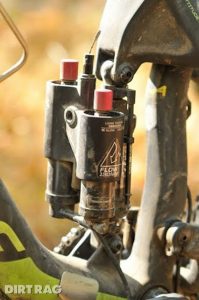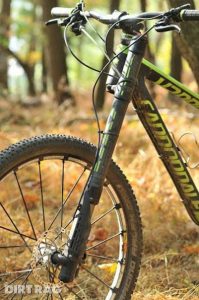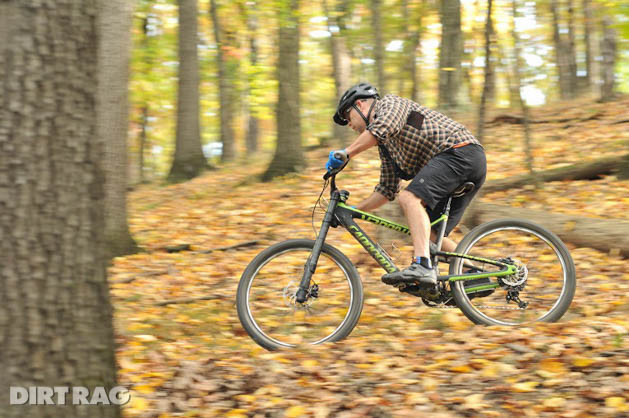Trail Tested: Cannondale Trigger 27.5 Carbon Team
Originally posted on February 25, 2015 at 13:00 pm
Cannondale designed the Trigger 27.5 Carbon Team to be the quintessential quiver killer—the one bike to replace all others hanging in your shed. Featuring a 140mm-travel carbon Lefty SuperMax fork and Fox DYAD adjustable rear suspension, the Trigger is meant to climb just as well as it descends and comfortably whisk you through everything from that quick local loop to an all-day backcountry adventure. Loaded with an impressive set of components, it surely looks up to the task. The Carbon Team version comes with a SRAM X01 10-42 rear cassette matched to a 30-tooth front ring, XX1 rear derailleur, Magura MT6 brakes, and carbon handlebars.
Like a lot of people, I hadn’t put in an extended amount of time on a bike that featured something as polarizing as Cannondale’s Lefty fork, so when the opportunity to review the Trigger was presented, I jumped. I wanted to find out what it was all about. What I hadn’t realized is that one of the more interesting things about this slick machine was not in the front but rather in the rear: the Fox DYAD RT2 shock.


The DYAD is pretty much two shocks in one. Easily controlled with a handlebar-mounted switch, the two modes of the shock are designed to excel in very different environments. “Elevate” utilizes only one of the shock’s two chambers and sets the travel to 85mm. “Flow” opens up both chambers and delivers 140mm. Along with the change in travel, each mode has a dedicated damping circuit and spring rate.
In addition, the two modes affect the bike’s geometry through what Cannondale calls Attitude Adjustment. Elevate sets your weight farther forward and limits sag, increasing the bike’s steering responsiveness and climbing posture, while Flow drops the bottom bracket by 1cm and slackens the head-tube and seat-tube angles, setting you up for rowdier sections of trail.

Out on the trail, it really does work. Weighing in at a scant 24.8 pounds, the Trigger naturally climbs well in either mode, but Elevate placed my body in a great position and stiffened the rear suspension considerably, allowing me to attack those extended flat and uphill sections. The bike acted more cross-country than I was expecting, but in a good way. The rear wheel remained well planted and provided me with all the traction I needed for some of the more challenging climbs.
While in the DYAD’s Flow setting, the rear suspension was very predictable and plush. Rock gardens, jumps and berms on my favorite trails just felt smoother. I’m not one for complexities on bikes, and I think a shock that has two separate chambers, negative and positive air-pressure settings and dials for both low-speed and high-speed compression is a bit much… but it works.
So the rear suspension is solid; how about the front? Yes, that Lefty SuperMax looks odd, but it works well. The fork is stiff and has a really nice feel at 140mm of travel. The best way I can describe it is smooth throughout its travel. It’s also well matched to the shock. The top of the fork has Cannondale’s PBR system: Rebound (R) is controlled with a dial, while lockout is controlled via a push button (PB) in the middle of the dial. The PB is ingeniously simple to operate, which is great on trail when you need to quickly set your fork for a climb or descent. Just in case you completely hate the Lefty, the Trigger is compatible with a standard fork. The two aluminum Trigger builds even come with a Fox Float 32 fork.
The Trigger’s 68-degree head tube (67.5 degrees when the DYAD is set to Flow) is right in the sweet spot for a trail bike. There’s enough there to get you through the rough stuff, but not too much to hinder your climbs. The bike is also very light, responsive, and incredibly fun to ride. Braking is good. The Team comes with Magura MT6s and big rotors: 180/160. The Reverb Stealth dropper performed well but exhibited noticeable play out of the box.

One pretty big disappointment for me was the Mavic CrossMax SLR wheels and Schwalbe tires. The internal width of the rims is a paltry 19 mm—way too narrow for such an otherwise capable bike. I would have much rather had something in the mid-20s. Pair the Team’s narrow rims with Schwalbe Racing Ralphs and you’ve got a tire that feels like it’s going to fold when you really push it hard into the corner—not the most confidence-inspiring setup. It’s worth noting that the Black Inc. build does come with Enve 650B AMs, which are 24mm wide, but that will run you an additional $2,500.
Overall, I think Cannondale did an incredible job with this bike and came very close to the “one bike to rule them all” that a lot of us are looking for. It’s a great climbing machine that, with the flick of a switch, turns into a screamer going back down. I’m definitely going to use it as a benchmark for many of my future reviews. You will have to pay a bit for all its prowess, though: The Trigger Carbon comes with the pretty hefty price tag.

Vital stats
- Price: $8,340
- Sizes: S, M, L (TESTED), XL